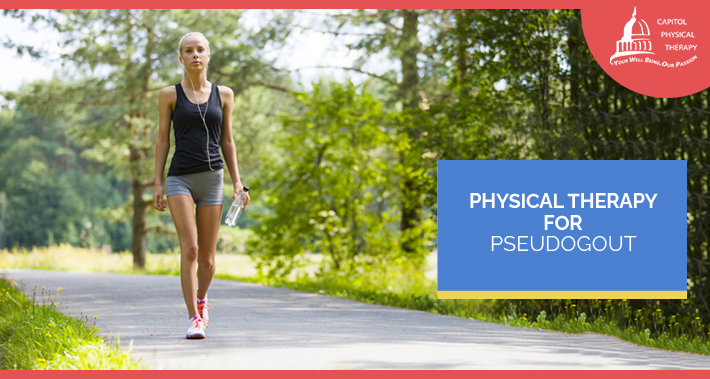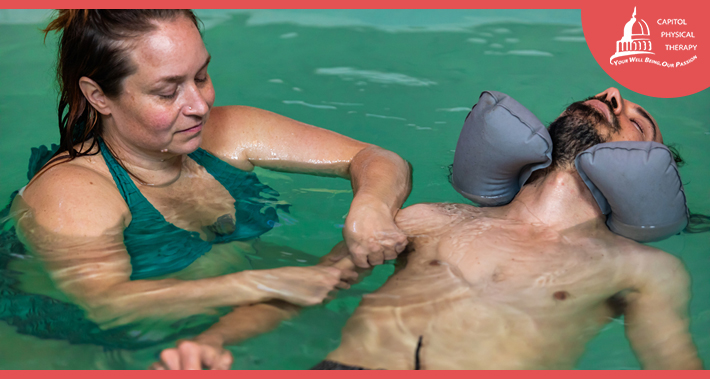
Pseudogout can cause pain, swelling, and inflammation in joints like your knees, wrists, hips, ankles, and elbows.
This form of arthritis can easily be confused for other conditions like rheumatoid or osteoarthritis.
Working with an orthopedic physical therapist can help you identify and find relief for pseudogout.
What Is Pseudogout?
When we think of arthritis, we might think of its most common form – osteoarthritis.
However, there are other types of arthritis as well.
This includes rheumatoid arthritis, an autoimmune disorder that attacks the myelin in your joints.
We’ve also come to understand fibromyalgia as a form of arthritis.
Pseudogout is also a type of arthritis that involves swelling and pain in specific joints.
Your body contains three types of joints – fibrous, cartilaginous, and synovial.
Pseudogout affects only your synovial joints, like your knees, wrists, ankles, elbows, and hips.
In your synovial joints an outer wall called the articular capsule connects your bones and houses the joint cavity.
Your articular capsules are lined by thin layers of soft tissue called the synovial membranes, or synovia.
Your synovia produce your synovial fluid, a liquid made of ultrafiltered plasma from your blood.
Synovial fluid lubricates your joints and maintains the health of the cartilage that lines your bones.
Pseudogout occurs when calcium pyrophosphate dihydrate (CPP) crystals build up in your synovial fluid.
CPP build up in the synovial fluid can trigger an immune reaction, causing inflammation and pain.
RELATED: Physical Therapy Natural Pain Management Solutions
Pseudogout is also known as false gout and calcium pyrophosphate dihydrate crystal deposition (CPPD) disease.
What Does Pseudogout Pain Feel Like?
Pseudogout can cause spontaneous swelling and pain in your synovial joints, most often the knees.
Pseudogout can be acute, lasting two weeks or less, or chronic, with recurrent pain and swelling over weeks or months.
Acute pseudogout usually affects fewer than five joints in the body.
Symptoms of acute pseudogout occur in and around the joints, and include:
- Sudden redness
- Warmth
- Inflammation
- Severe pain
Acute pseudogout may also be accompanied by a low grade fever
Chronic pseudogout can involve one or multiple synovial joints, including the shoulders, wrists, large knuckles, and feet.
Chronic pseudogout symptoms and symptoms of osteoarthritis and rheumatoid arthritis are similar.
They include:
- Shoulder pain
- Hip pain
- Knee pain
- Ankle pain
- Wrist pain, unrelated to carpal tunnel syndrome
- Elbow pain, unrelated to tennis elbow
- Chronic, mild aches
- Swelling
- Redness
- Cartilage deterioration
- Decreased range of motion
Pseudogout can also lead to fluid buildup around the joint.
What Is The Main Cause Of Pseudogout?
We know that the pain and swelling associated with pseudogout is the result of an immune response to CPPD.
CPP crystals form in the cartilage where they can cause damage.
Sometimes the cartilage will release those CPP crystals, leading to damage to other tissues in the joint.
Researchers have yet to identify why some people develop CPPD, and why some people with CPPD do not have pseudogout symptoms.
The likelihood of developing CPPD increases with age and is more likely in people with a family history.
Other health factors associated with pseudogout include:
- Amyloidosis, or irregular protein buildup
- Hemophiliia, a condition that prevents blood from clotting
- Hereditary hemochromatosis leading to too much iron in the blood
- Hypercalcemia – too much calcium in the blood
- Hyperparathyroidism leading to too much calcium in the blood
- Hypothyroidism – an underactive thyroid gland
- Ochronosis, a condition that causes staining on the cartilage and connective tissues
- Osteoarthritis
- Magnesium deficiency
- Type 2 diabetes
How Common Is Pseudogout
Pseudogout is more common than you might think – this is because it often goes unrecognized.
Some people have CPPD without symptoms of pseudogout.
This occurs when calcium pyrophosphate dihydrate crystals can be found in the joint, but don’t cause any pain.
Because symptoms overlap with other forms of arthritis, pseudogout can be mistaken for rheumatoid or osteoarthritis.
This means that many people who have pseudogout don’t know it.
Pseudogout is more common amongst people over the age of 60 and is strongly associated with osteoarthritis.
RELATED: Physical Therapy For Seniors To Stay Healthy
How Do You Diagnose Pseudogout?
There are a few different methods your doctor can use to identify whether you have pseudogout or not.
Your doctor may order imaging like an x-ray, ultrasound, MRI, or CT scan.
Imaging of the joint or joints that are bothering you can help your doctor inspect for injury or calcium buildup.
Your doctor may also order arthrocentesis, a procedure that uses a needle and syringe to withdraw some of your synovial fluid.
Your synovial fluid can then be tested for calcium pyrophosphate.
What’s The Difference Between Pseudogout and Gout?
Both pseudogout and gout are forms of arthritis in which crystal buildup leads to pain and inflammation in the joints.
Aside from these commonalities, pseudogout and gout differ in a few important ways.
The effects of pseudogout are limited to your synovial joints, like the knees, ankles, wrists, hips, and elbows.
Gout primarily affects your big toes and may also impact your lesser toe joints and your knees.
While both conditions are caused by a build up of crystals in the joints, gout is caused by urate, or uric acid, crystals.
Uric acid is a waste product that your body creates and eliminates naturally.
Doctors don’t know why CPP might build up in your body, but there are several known reasons why uric acid might.
Uric acid can spike if you eat a lot of foods that are high in a substance called purine.
Purine rich foods include:
- Anchovies
- Mussels
- Sardines
- Scallops
- Trout
- Tuna
- Beer
- Other alcoholic beverages
- Beverages sweetened with fructose, a natural sweetener
Uric acid can also build up in the body if you are taking certain medications or have certain medical conditions.

How Can Physical Therapy Help With Pseudogout?
Research has yet to identify a cure or a medication that will prevent calcium pyrophosphate dihydrate deposition.
Physical therapy can provide relief from the pain, swelling, and loss of mobility that you experience with pseudogout.
By working with a physical therapist, you may find significant relief from both acute and chronic pseudogout symptoms.
1. RICE
RICE stands for rest, ice, compression, and elevation.
You might be familiar with RICE as a common at home treatment for minor injuries like twists and sprains.
RICE is also an effective at home treatment for joint pain, inflammation and swelling.
Rest
Resting your joints can mean decreased activity – taking a day or two off from your normal physical tasks.
You can also rest your joints by modifying regular physical activities and movements.
Your physical therapist can show you aides, tools, and different postures and ways of moving that put less strain on your joints.
Ice
A cold compress on your joints can help reduce swelling and relieve some of your pain.
For chronic pseudogout, cold can also give you another sensation to focus on, making pain less overwhelming.
If you don’t have a cold pack at home, try putting some ice in a small plastic bag or soaking a towel in cold water.
RELATED: Understanding Heat And Cold Therapy
Compression
Compression is known to improve blood circulation, which helps your joints in a few ways.
Increased circulation helps your joints heal and eases pain and inflammation.
Depending on which joints give you trouble, you might be able to use compression socks, gloves, braces, or tape for relief.
Elevation
If you are able, find a position that elevates your painful joint.
Elevating your joints can relieve swelling and inflammation.
This might mean sitting with your feet on a footstool, or propping your foot or elbow up on a pillow while you lie down.
Your physical therapist can also recommend stretches or exercises that include elevation.
2. Exercises
Your physical therapist can show you a variety of exercises to preserve your range of motion and decrease stiffness and pain.
During active flare ups of pseudogout, moderate range of motion activities can encourage fluid circulation.
Gently move your affected joints as much as you can, exploring the full range of motion.
Your physical therapist can also show you strengthening exercises for days when your pseudogout is not active.
For general health and pain management, try exercises with low joint impact, like walking, cycling, or aquatic exercise.
Exercising in water is helpful for people with pseudogout because buoyancy prevents joint stress as you move.
3. Edema Control
Edema is the swelling that occurs when there is too much fluid in part of your body.
You can control swelling in its early stages by wrapping your joints.
By wrapping your joint, you restrict the amount of space available for fluids to collect.
This forces the fluid away from your joint, preventing the pain, stiffness, and loss of mobility that can accompany edema.
This is a great option if you have chronic pseudogout and have started to recognize the onset of your symptoms.
It is best to wrap your joint before swelling has progressed very far.
If your joint is already quite swollen, try using ice and elevation to bring the swelling down before wrapping.
Book Your Appointment With Capitol Physical Therapy Today
Pseudogout can be a very painful condition.
Learning more about how this chronic condition affects your body can help you manage pain and get back to your daily life.
A physical therapist can help you learn more about your joint health and find treatments that work for you.
To get relief from joint pain, book your appointment with Capitol Physical Therapy today.
1331 H St NW #200,
Washington, DC 20005
- https://g.page/capitolptdc
9560 Pennsylvania Ave. # 202,
Upper Marlboro, MD 20772
- https://goo.gl/maps/zjL4NnnuThRhrcS86
Capitol Physical Therapy offers orthopedic and other pain related solutions, with our versitile team of physical therapists in Washington, DC